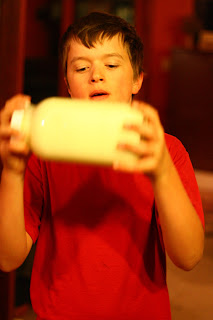Nothing compares to the sweetness and deliciousness of fresh raw cow's milk. I have read extensively about the many health benefits of natural milk with all its health building enzymes intact and am convinced that drinking raw milk as humans have all over the world since the beginning of history is the best way to consume this nutritious dairy product. Unfortunately because of the glut of misinformation, politics and fear-mongering, unless a person owns a jersey cow, it is getting harder and harder to obtain good, natural milk in America. (In France, they sell it in vending machines. But of course!)
Since our goats are not producing right now, I buy cow's milk for our family from a farm on the other side of the mountain at great expense with a heavy dose of time and effort to bring it here. But it is worth it. Tonight I had some extra cream so decided to make butter with it. If you have never seen fresh, non-homogenized cow's milk, you may not know that the cream naturally rises to the top of the milk and is easy to separate by pouring it off. (Separating cream from goat's milk is not that easy.)
To make butter, I put the cream into a clean jar, let it come to room temperature and enlisted an eager helper who has energy to spare. It isn't necessary to have any special equipment to make butter like butter churns or paddle jars. A simple jar with a tight fitting lid is all that is needed. Well, you also need some muscle, stamina, patience and perseverance. And muscle and stamina. And did I say patience? This is where having eager kids with young muscles is beneficial...
Start shaking the cream.
And shaking....
Keep shaking! Shake some more!!
Don't stop... keep shaking! Shake, shake, shake!!
After many minutes, hours...no, days and days!....of shaking, shaking, shaking....something magical appears!
Butter! The fat has separated from the milk and floats in what is now buttermilk.
Look at the lovely yellow color that spring grass makes. Some contented cows made this butter.
The next thing to do is pour off the buttermilk and wash the butter. Washing the butter in cold water rinses all the buttermilk out of the fat and this will keep the butter fresher, longer. Pioneers used to store their butter for long periods in their ice house. There is an old saying that "butter commends the housewife, good cheese, the cow" because well-rinsed butter tastes sweet and fresh for a long time. A little salt added after the washing also helps to preserve the butter.
Peter had a good time making his first batch of butter.
Mom! It's like......real butter!
His next question was- how do you make cheese? Can we make cheese?











